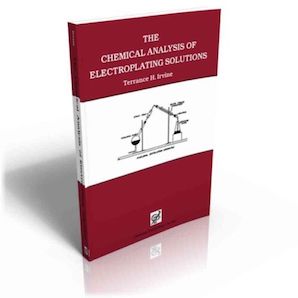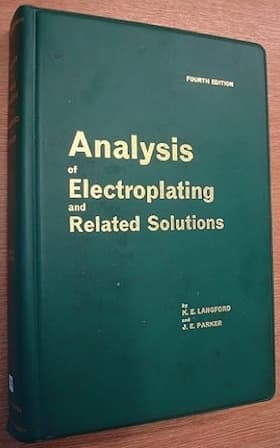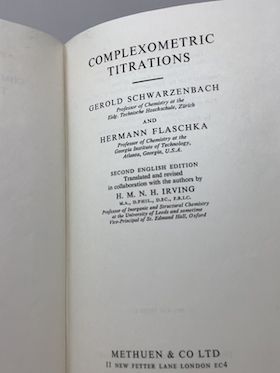
-----
How to analyze the acid level (HCl) in ferric chloride Solution
[editor appended this entry to this thread which already addresses it in lieu of spawning a duplicative thread]
Q. Hello,
I have a solution:
FERRIC CHLORIDE 40% 12 g/l
HYDROCHLORIC ACID 28% 30 g/l
How can I determine HCl?
chemist - Leicester
April 10, 2025
Multiple threads merged: please forgive chronology errors and repetition 🙂
Q. Hi, can anyone suggest any methods to analyze the Hydrochloride percentage level in the ferric chloride ⇦ on eBay or Amazon [affil link] solution?
Albert Tsang- England, U.K.
2001
A. Titrate a 5 ml sample diluted to 100 ml with 1.0N NaOH [1N NaOH on Amazon [affil link] to the yellow methyl orange ⇦ on eBay or Amazon [affil link] endpoint. mls NaOH used x 7.3=g/l HCl mls NaOH used x 19.67=ml/l 32% HCl mls NaOH used x 1.97=% v/v 32% HCl

James Totter, CEF
- Tallahassee, Florida
A. If you use 1.0N NaOH [1N NaOH on Amazon [affil link] , you will also precipitate a fair amount of the iron giving you poorly repeatable results that will be high. Use 0.1N and divide the fudge factors by 10 to reflect the 10 times weaker titrant. Use lots of agitation and a relatively slow addition of the titrant. Play around with the amount of indicator that you use. Too little or too much make it a very hard endpoint to find. The right amount makes it a piece of cake. You can also use a pH meter. Just remember that it takes 10 to 20 seconds for it to give you a true reading.
James Watts- Navarre, Florida
A. There are alternatives to the base titration. The NaOH titer by indicator will include a portion of any ferric ion [Fe(III)] as HCl. The amount of base titer consumed and counted as HCl will vary directly with the level of ferric ion in the solution. To avoid poor endpoints and pH plots, you may measure both the total chloride by ISE and Fe(III) by EDTA, using a glycine buffer and sulfo-salicylic acid as indicator - see "Complexometric Titrations" by Schwarzenbach & Flaschka ⇨
To estimate the free HCl molarity subtract four times the Fe(III) molarity from the total chloride molarity. Calculate the difference as HCl. Use this technique if extreme accuracy isn't needed and total acid strength is not important.
- Cleveland Heights, Ohio
A. You seem to have all the answers that you need, but one other suggestion is to use a small sample and the dilute NaOH and add approx. 1g of potassium fluoride ⇦ on Amazon [affil link] (KF) to hold up the iron.

Martin Trigg-Hogarth
surface treatment shop - Stroud, Glos, England
A. Dear Mr. Tsang,
The first thing you have to do is "tie-up" the iron ion, thereby achieving the most accurate results. The procedure is as follows:
1. Pipette
[pipettes on
eBay or
Amazon [affil link]
a 5 mL aliquot of the working solution into a 250 mL Erlenmeyer flask.
2. Add 100 mL DI water and 20 mL potassium fluoride solution, 10 w/v%.
3. Add 10 drops phenolphthalein
⇦ on
eBay &
Amazon [affil link]
solution, 1.0 w/v %.
4. Titrate sample against 1.0 Normal sodium hydroxide solution. Color change will be turbid white to constant pink.
5. Record volume of titrant consumed.
Calculation: v/v % 22Be HCl = mL 1.0N NaOH X 1.82

Randall Fowler - Fowler Industrial Plating, LLC
Cleveland, Tennessee, USA
Q. Dear Sir,
Thanks for those people whose gave me the titration methods last time, thanks you so much. But I got an other problem because the ferric chloride ⇦ on eBay or Amazon [affil link] solution contained high percentage of other metal ions like copper and brass. Also contained carbon (like black dust), so can anyone tell me that is the titration method still work in this situation or I need to use other testing method to get a better result.
Albert Tsang- England, U.K.
by Terrance H Irvine

on eBay or Amazon
or AbeBooks
(affil link)
Dear Albert,
The only response I have to that question is as follows:
1. Can you say filtration? (sorry, trying to be funny) The carbon particulates you describe do not contribute to the titration reaction, and can easily be filtered out of solution using fluted, qualitative paper or microfiber filters.
2. It sounds like what you need to do is the same thing that I always do when I encounter an "unknown solution": Prepare standards.
3. Here's how I would prepare the standard which you describe:
a) Make up an ideal lab standard solution of the working bath. A standard which contains the optimum working agents.
b) Perform your accepted titration procedure upon this solution. Record your results.
c) Heat a known volume of the sample (in the lab) to the optimum working temperature.
d) Pass some "work" through the sample. This work should consist of brass and copper parts which you usually run. Keep a weighed, mass measurement of the parts you ran through.
e) Filter the sample, then run the same titration procedure again upon the second sample. Record results.
f) Establish a linear constant based upon the difference between the first standard and the second standard. These numbers will yield the math you need to your process control procedure.
Keep me in touch. I'm interested in your plight.
Truly,

Randall Fowler - Fowler Industrial Plating, LLC
Cleveland, Tennessee, USA
I think now might be a good point to step back and ask yourself why am I doing this?
Why are you wanting to analyse the hydrochloric acid content?
If it is solution control a better answer might be to just go with the very simple answer of run a sample until it is not doing the process you want. Take samples every few loads (be sensible so you end with 5 to 10 samples for a bath life) Analyse these by a very simple titration NaOH and phenolphthalein ⇦ on eBay & Amazon [affil link] (I hope I can still spell) and see if there is a pattern - do the results rise? do they fall?
If you see a pattern is it such that you can draw a line and say once it crosses that line it is time to dump the solution.
I expect many of the people will have reached the point where the lab say the solution is fine, the shop floor say it is not and when you look you find it is some contamination issue that is not tested for so the lab are right when they say they can not fine anything wrong with the solution and the shopf loor are right when they say they cannot get a good job out of it.
Testing like described above will give a robust answer and take into account the effects of the.

Martin Trigg-Hogarth
surface treatment shop - Stroud, Glos, England
Q. Hi
Is there an instrument that can test the HCl concentration in ferric chloride
⇦ on
eBay or
Amazon [affil link] inline?
- Gauteng, South Africa
April 12, 2013
Q. I am attempting to determine concentration in an HCl pickling solution. I am using a pH method: 5 ml of solution, add 50 ml distilled water, titrate with 1N NaOH to a pH of 4, mls NaOH x .73 = % HCl
My question is, is this result also affected by iron contamination in the solution? This is probably an easy one, but I'm no chemist ;/
by Langford & Parker

on Amazon
or AbeBooks
(affil link)
- Northbridge, Massachusetts, USA
June 28, 2013
A. What you suggest will work IF you add the NaOH very slowly. If you add it too fast, the pH in a localized area will drop out some iron giving you a false reading. The iron hydroxide is very slow to redissolve.
I would prefer to use a 1 ml sample and titrate with 0.1N NaOH.
I would use a class A pipet or a calibrated cheap one for the one ml sample. I would also let the main sample set for a few min before taking the 1 ml sample.
Another way is to do an accurate dilution of the sample and then take a 5 ml sample of that.
Adjust your fudge factor accordingly.
- Navarre, Florida
Readers may also be interested in these related threads:
• Topic #256/87 "Procedure for Titration of ferric chloride?"
• Topic #429/58 "Looking for a titration method for ferric chloride"
Q, A, or Comment on THIS thread -or- Start a NEW Thread
 on eBay
on eBay